Podcast: Play in new window | Download (Duration: 8:03 — 9.0MB)
Thanks to River for suggesting this week’s topic, the pufferfish!
Further reading:
Grass puffer fish communicate with each other using a non-toxic version of their deadly toxin
Mystery pufferfish create elaborate circular nests at mesophotic depths in Australia
Pufferfish, puffed:
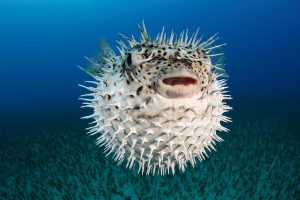
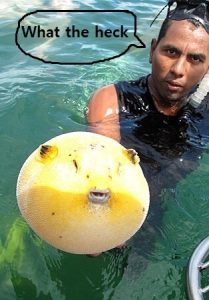
A starry puffer, un-puffed [picture by Diego Delso, CC BY-SA 4.0, https://commons.wikimedia.org/w/index.php?curid=116912671]:
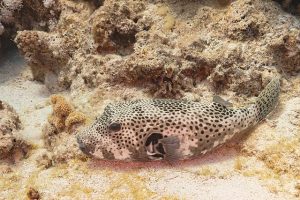
A grass puffer, un-puffed:
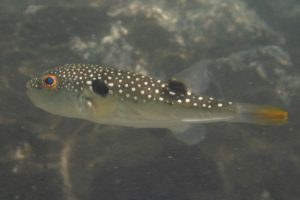
The mystery structure that turns out to be made by pufferfish:
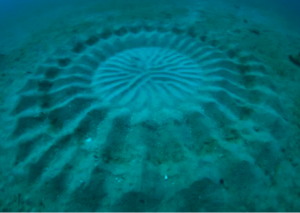
Show transcript:
Welcome to Strange Animals Podcast. I’m your host, Kate Shaw.
This week we’re going to learn about a weird fish suggested by River, the pufferfish!
Lots of fish have the name pufferfish, and sometimes they’re also called balloonfish, swellfish, bubblefish, or globefish. You might be able to guess from the names what they can do, but just in case you don’t know, the pufferfish can puff up to make itself big and round. The question you might have at this point is why, and how do they do this?
There are lots of pufferfish in various genera, all of them in the family Tetradontidae. Tetradontidae means “four teeth,” because obviously when you find an incredibly poisonous fish that can blow itself up like a balloon, sometimes with spikes that emerge from the skin, of course you’re going to name it after its teeth.
Most pufferfish live in the ocean, although some live in places where freshwater mixes with ocean water, and some species even live in rivers. It prefers warm, shallow water and eats invertebrates and plant material. Larger pufferfish can use their four big front teeth to crush the shells of mollusks, like clams and mussels.
Most pufferfish are quite small and often brightly colored with spots, stripes, and other markings. You’d think the biggest pufferfish has to be the one called the giant freshwater pufferfish, but while it is big, it’s not the biggest. The giant freshwater pufferfish can grow up to 26 inches long, or 67 cm, which is over two feet long. But the starry puffer is almost twice that length, up to 47 inches long, or 120 cm. That’s almost four feet long!
The starry puffer lives in tropical and subtropical parts of the Pacific Ocean, especially in the Indian Ocean and the Red Sea. It has a big head, two pairs of nostrils, and is a mottled gray and white in color with little black spots all over. It mostly eats crustaceans and mollusks, but will also eat algae, sponges, coral, urchins, and other invertebrates.
The pufferfish is a slow swimmer, but it has two really good defenses. If it feels threatened—for instance if a big fish tries to catch it, or it’s caught in a fishing net and hauled to the surface, or if a diver tries to make friends, the pufferfish will swell up until it looks like a balloon with fins. It does so by gulping air or water into its elastic stomach until it’s completely full.
If you’re wondering how this can help the fish, not only does this make the pufferfish look much larger, it also makes it harder to swallow. Not only that, the pufferfish has spines that may be hidden in the skin most of the time, but when the skin tightens as the fish expands into balloon shape, the spines poke out. Suddenly a potential predator isn’t just trying to swallow a fish way bigger than its mouth is, it’s pointy.
The pufferfish’s second defense is that its body contains a deadly poison. You may have heard about fugu, which is considered a delicacy even though it’s so poisonous that in Japan and some other countries, chefs have to be specially trained and licensed to prepare the fish to eat. It contains tetrodotoxin, or TTX, a neurotoxin that stops your nerves from sending the tiny electrical signals that allow muscles to move. If you’re poisoned with TTX, you start to feel dizzy and sick, then you start having difficulty speaking and moving, then you have trouble breathing, and then, ultimately, you’re paralyzed and can’t breathe, at which point you die. Since the toxin doesn’t affect your brain, you remain completely aware of what’s happening to you but there’s nothing you can do about it. There’s no antidote. Fortunately, you have the option of not eating fugu.
Not all pufferfish are poisonous, although most are, and in many species the amount of toxins in the fish’s body can vary according to the time of year and the individual fish. People who have eaten their local pufferfish many times with no problem can suddenly get sick or die from eating the same type of fish. That’s the bad type of surprise.
At least some pufferfish use their toxins for a surprising purpose. In late 2022, a study was published about the grass puffer, also called the grey-spotted puffer. It’s a small fish that grows not quite 10 inches long, or 25 cm, and is gray with tiny white spots. It’s extremely toxic but its body also contains a non-toxic version of TTX, called TDT. Scientists studying the fish determined that other grass puffers can smell TDT in the water so they can find each other. Not only that, other animals found in the same environment where the grass puffer lives also contain both TTX and TDT, and the pufferfish eats those animals. Naturally, it can find its prey by smell.
Let’s finish with a pufferfish mystery that’s been solved. In 1995, divers in southern Japan noticed a series of mysterious underwater structures in the sand. They were about six feet across, or close to two meters, round in shape, and looked sort of like someone had packed sand into a giant one of those fancy decorative cake pans that make designs around the cake, and turned it out upside down underwater. No one could figure out what they were, how they’d been made, or why they were there. People started calling them underwater crop circles.
It wasn’t until 2011 that the mystery was solved, when a diver saw one of the circles being formed by a little pufferfish. The fish turned out to be new to science and was described in 2014, and is popularly known as the white-spotted pufferfish. The male builds the structure by waving his fins to move sand into geometric shapes and concentric rings, a process that takes over a week. Since water keeps moving the sand, he has to keep working on the structure to keep it looking good, and he wants it to look good because that’s how he attracts a mate. The specific patterns he creates direct water currents to the center of the structure, where it deposits fine, soft sand. If a female likes the structure, she will lay her eggs in the soft sand in the middle so that the male can fertilize them.
In 2018, similar nests were discovered off the coast of western Australia, but so far no one knows whether the nests are built by a known species of pufferfish or a species new to science.
You can find Strange Animals Podcast at strangeanimalspodcast.blubrry.net. That’s blueberry without any E’s. If you have questions, comments, or suggestions for future episodes, email us at strangeanimalspodcast@gmail.com. We also have a Patreon at patreon.com/strangeanimalspodcast if you’d like to support us for as little as one dollar a month and get monthly bonus episodes.
Thanks for listening!